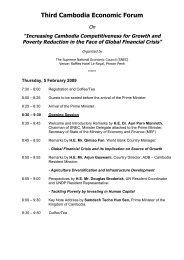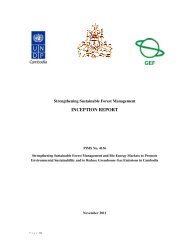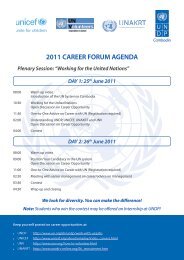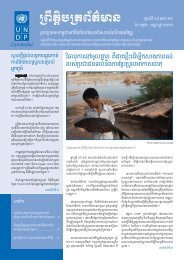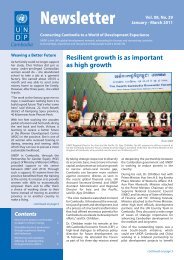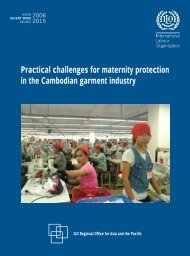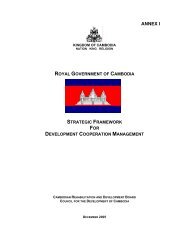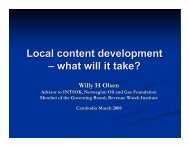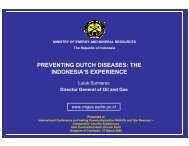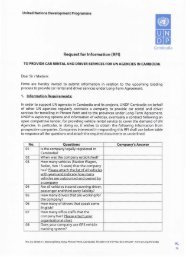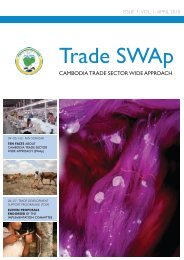UN Analysis Final.pdf - United Nations in Cambodia
UN Analysis Final.pdf - United Nations in Cambodia
UN Analysis Final.pdf - United Nations in Cambodia
You also want an ePaper? Increase the reach of your titles
YUMPU automatically turns print PDFs into web optimized ePapers that Google loves.
EMPLOYMENT<br />
The s<strong>in</strong>gle most important issue confront<strong>in</strong>g youth <strong>in</strong> <strong>Cambodia</strong> today is employment. The labour force is<br />
<strong>in</strong>creas<strong>in</strong>g by as many as 300,000 per year, and will <strong>in</strong>crease to as many as 400,000 per year <strong>in</strong> the near future.<br />
The garment, tourism, and construction <strong>in</strong>dustries are not grow<strong>in</strong>g sufficiently quickly to absorb so many<br />
new labour market entrants. As a result, the Government’s Rectangular Strategy, as outl<strong>in</strong>ed <strong>in</strong> the National<br />
Strategic Development Plan (NSDP) 2006 – 2010, details steps to develop the agricultural sector as a “third<br />
eng<strong>in</strong>e” of growth. On-farm employment is, however, constra<strong>in</strong>ed by <strong>in</strong>secure land tenure, lack of affordable<br />
credit, fragmented <strong>in</strong>puts and services, a lack of <strong>in</strong>frastructure, and poorly function<strong>in</strong>g markets. Off-farm<br />
employment seems to have great potential but more effort is needed to stimulate Small and Medium<br />
Enterprise (SME) development and agri-bus<strong>in</strong>ess <strong>in</strong>vestments. There is a need to attract foreign <strong>in</strong>vestment<br />
<strong>in</strong> agri-bus<strong>in</strong>ess and to strengthen the bus<strong>in</strong>ess-enabl<strong>in</strong>g environment.<br />
Moreover, as the economic structures of the region change, there is need for <strong>Cambodia</strong> to not only absorb<br />
the grow<strong>in</strong>g labour force, but to prepare young people for the next generation of jobs. For example, as<br />
<strong>Cambodia</strong>’s agricultural sector <strong>in</strong>tensifies and diversifies, there will be a greater reliance on mach<strong>in</strong>ery and<br />
transport that will require skilled mechanics for ma<strong>in</strong>tenance and repair. There is also a need to match<br />
these opportunities with affordable credit to support SME start-ups. Even <strong>in</strong> the face of immediate needs,<br />
such medium and long range plann<strong>in</strong>g is critical.<br />
EDUCATION<br />
Education promotes economic growth though <strong>in</strong>creased productivity, the acquisition of new skills and<br />
attitudes, and through the accumulation of knowledge itself. The role of education <strong>in</strong> reduc<strong>in</strong>g poverty<br />
and <strong>in</strong>come <strong>in</strong>equality is also well established. In this sense, illiteracy is one of the strongest predictors of<br />
poverty, while unequal access to educational opportunity is one correlate of <strong>in</strong>come <strong>in</strong>equality (World Bank,<br />
2006a). Complement<strong>in</strong>g the f<strong>in</strong>d<strong>in</strong>gs from a previous <strong>Cambodia</strong>n Development Research Institute (CDRI)<br />
poverty study, this research found that <strong>in</strong>vestments <strong>in</strong> girls’ education could yield some of the highest<br />
returns of any development <strong>in</strong>vestment, such as foster<strong>in</strong>g more young female participation <strong>in</strong> the<br />
development process and welfare, and reduc<strong>in</strong>g some of the most pernicious effects of poverty. In focus<br />
group discussions (FGDs) with young women aged 20-24, a majority consistently said that, with even a<br />
few years of formal education, they could better plan their families and have fewer children, have better<br />
knowledge of how to provide children with better nutrition, ensure they are immunized, and procure<br />
appropriate medical care for their children. Education therefore can also be an important vehicle for<br />
improv<strong>in</strong>g health and promot<strong>in</strong>g preventive health practices.<br />
The Education Strategic Plan (2006-2010) outl<strong>in</strong>es the Government’s efforts for promot<strong>in</strong>g the National<br />
Plan for Education for All 2003-2015. to achieve the <strong>Cambodia</strong> Millennium Development Goal (CMDG) of<br />
ensur<strong>in</strong>g access to n<strong>in</strong>e years of basic education for all young people. In support of this goal, significant<br />
progress has been made <strong>in</strong> <strong>in</strong>creas<strong>in</strong>g the number of primary and lower secondary schools, and improv<strong>in</strong>g<br />
enrolment levels <strong>in</strong> lower secondary education, and adult literacy (among those aged 15-24). A key<br />
<strong>in</strong>dicator of progress <strong>in</strong> this regard is that national expenditure on education has steadily <strong>in</strong>creased s<strong>in</strong>ce<br />
2000. Budgets have been primarily allocated for primary and lower secondary education for schools and<br />
materials, and teacher tra<strong>in</strong><strong>in</strong>g. Policies have also been adopted to encourage greater participation by girls<br />
and disadvantaged youth (e.g., those with disabilities, ethnic m<strong>in</strong>orities) <strong>in</strong> education.<br />
Situation <strong>Analysis</strong> of Youth <strong>in</strong> <strong>Cambodia</strong><br />
3




